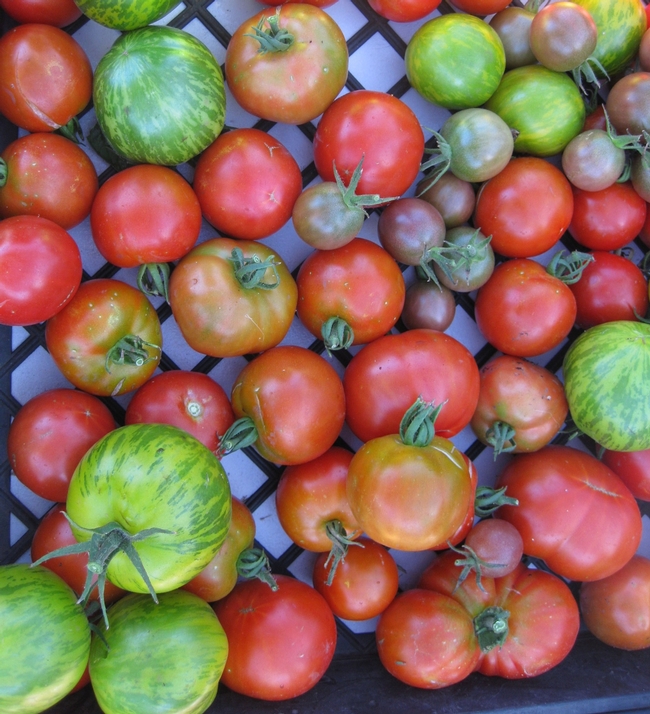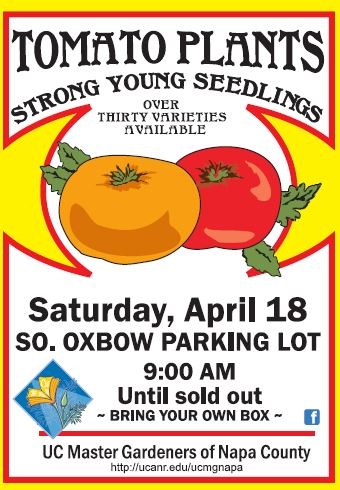
In the cherry category, ‘Sun Gold' is a perennial favorite of Napa County Master Gardeners. Steve Rae also likes ‘Miller's Cove Currant'. It produces incredible numbers of half-inch, sweet red tomatoes over the entire season. I like ‘Black Cherry'. It has the rich taste common to the so-called black tomatoes and holds up better to roasting than most cherry tomatoes.
Which varieties to choose for making sauce or paste or for drying? Pat Hitchcock grew the hybrid ‘Big Mama' last year and says this plant was a great producer and perfect for sauce. I grew ‘Opalka', a Polish heirloom paste tomato. I will grow it again because it was so meaty and had few seeds. I used it for sauce but also found it ideal for bruschetta and for drying.
Some Master Gardeners are big fans of black tomatoes. Mickey Riva, Marci Nielsen‑Berruezo and Lorie Mazzaroppi all sing the praises of ‘Black Krim'. Marci describes it as dark and mysterious in appearance and rich in flavor, with a natural saltiness that adds complexity. One of my dark favorites is ‘Paul Robeson'. It resembles Cherokee Purple' in flavor but produces earlier and is extremely prolific. Penny Pawl and Helen Bergin favor ‘Japanese Black Trifele'. It is the only variety that Penny grows, and Helen loves its taste,appearance and resistance to cracking.
Do you have room in your garden for only one tomato? For length of harvest and consistent performance, Gayle Keane and Jo Moore swear by ‘Early Girl'. Amelia Ceja loves ‘Green Zebra' for its flavor, beautiful color and suitability to the cool Carneros region. She uses it for her spicy, fire-roasted tomato salsa. David Layland's favorite is ‘Bloody Butcher', an early producer that persists well into fall.
Many gardeners grow large tomatoes for slicing. Some prefer traditional all-red varieties, while others favored multicolored types. Meredith Lavene loves ‘Red Brandywine', which won the large tomato category in last year's Napa County Master Gardeners taste test. Lois Quick prefers ‘Marvel Stripe'. Orange and yellow outside, this large tomato reveals streaks of red, yellow and orange when sliced. It has a sweet, fruity taste. Mike Weinberg grows ‘Pink Berkeley Tie Dye' for its size, taste, yield and beauty.
If you are looking for new tomato varieties to try, ask yourself these questions. How do you plan to use the fruit? Will you be cooking and preserving your tomatoes, or do you primarily eat them fresh? How much room do you have in your garden? How would you rank the importance of flavor, appearance, productivity and disease resistance? Research the characteristics of different varieties before you make your choices. Decide whether you prefer hybrids or heirlooms or want to grow some of each.
Many hybrid varieties have been bred for productivity and resistance to diseases that plague tomatoes. On plant tags, look for the letters V,F,N,T and A, which indicate resistance to Verticillium wilt, Fusarium wilt, nematodes, tobacco mosaic virus and Alternaria stem canker.
Heirloom tomatoes offer a wide spectrum of flavors, colors, textures and shapes. While heirlooms may not be as productive as hybrids and tend to be more susceptible to disease, many home gardeners appreciate them for their unique characteristics. What's more, you can save and replant heirloom tomato seeds next year; in contrast, seeds from a hybrid variety will not “come true,” or produce an identical tomato when replanted.
Whichever varieties you choose, wait until the danger of frost is past and the soil is sufficiently warm to plant your tomatoes. Soil temperatures below 57ºF delay growth and leave the plants more susceptible to insect damage and disease. Tomatoes planted later usually catch up with those planted in colder weather. I wait until the last week in April to plant mine, and even then, I watch the forecast so I can cover them if frost threatens.
Tomato Sale and Education Event: Napa County Master Gardeners are hosting their third annual Tomato Sale on Saturday, April 18. Join us in the South Oxbow parking lot in Napa, 9 a.m. until sold out. We have a bountiful selection of strong, young plants: heirlooms, hybrids, cherry, paste and just plain good eating tomatoes of all sizes. Remember to bring your own box to safely transport your plants home. Click on the link above to read descriptions of the varieties for sale.
Master Gardeners are volunteers who help the University of California reach the gardening public with home gardening information. Napa County Master Gardeners ( http://ucanr.org/ucmgnapa/) are available to answer gardening questions in person or by phone, Monday, Wednesday and Friday, 9 a.m. to Noon, at the U. C. Cooperative Extension office, 1710 Soscol Avenue, Suite 4, Napa, 707-253-4143, or from outside City of Napa toll-free at 877-279-3065. Or e-mail your garden questions by following the guidelines on our web site. Click on Napa, then on Have Garden Questions? Find us on Facebook under UC Master Gardeners of Napa County.


Probably I will repeat many of our favorites, but I will also try a few new ones. Which types to choose? There are so many factors to consider.
Do I want to try a new variety for cooking and preserving, or for eating fresh from the garden? I have plenty of room for another tomato plant, but those with more limited space should consider whether a variety is suited to small spaces or containers.
Tomatoes are classified as either determinate or indeterminate based on their growth habits. Determinate tomatoes tend to be bushy in appearance. They grow to a certain height, generally three to five feet, and bear most of their fruit within a four- to six-week period. Determinate tomatoes are often chosen for canning since they yield so much at once.
Indeterminate tomatoes grow and bear fruit all summer, until the arrival of frost. These types need the support of trellises, stakes or cages to keep them from sprawling on the ground, where the fruit tends to rot.
Another characteristic to consider is disease resistance. Many hybrid varieties have been bred to resist diseases that plague tomatoes. When shopping for tomatoes, you may notice that the plant label includes the letters V, F, N, T or A. This is a code that indicates whether the variety is resistant to verticillium wilt, fusarium wilt, nematodes, tobacco mosaic virus or alternaria stem canker. Keep in mind that resistance does not mean immunity. Home gardeners should still practice crop rotation and avoid planting tomatoes or other members of the nightshade family (Solanaceae) in the same location for more than two consecutive years. That family includes eggplants, potatoes, peppers and petunias.
The popular heirloom tomatoes offer a wide range of flavors, colors, textures and shapes. While heirlooms may not be as productive as hybrids and tend to be more susceptible to disease, many home gardeners appreciate their variety. What’s more, heirloom seeds can be saved and replanted, and they will yield the same variety the following year. In contrast, plants from hybrid seeds don’t retain all the traits of the parent plants.
I generally grow a mix of heirlooms and hybrids so I have the best of both worlds. One of my favorite cherry tomatoes is ‘Sungold,’ an indeterminate hybrid that produces small golden-orange fruits with a tangy, sweet flavor. It is extremely productive. For a color contrast, I grow ‘Green Grape,’ an heirloom that is green on the inside and chartreuse outside when ripe. It is about the size of a large grape and has few seeds. It has a spicy sweet flavor and looks beautiful halved in salads.
‘Mamma Mia’ is my favorite variety for sauces, bruschetta and dried tomatoes. It’s the only variety that I grow in multiples because it is so versatile. It is meaty, ripens earlier than most plum tomatoes and lasts in my garden until the first frost.
For sheer beauty, I grow ‘Marvel Stripe’ every year. This indeterminate heirloom produces large multi-colored fruit with streaks of red, yellow and orange. It is a star in any caprese salad.
My best-tasting tomatoes are ‘Japanese Black Trifele’ and ‘Cherokee Purple.’ Both are indeterminate heirlooms with dark fruit and rich, complex flavor. ‘Cherokee Purple’ produces large tomatoes while the ‘Japanese Black Trifele’ is a medium-sized pear-shaped tomato.
Napa County Master Gardeners have compiled a list of 44 favorite tomatoes that grow well in the county. For more information about these varieties, visit http://ucanr.edu/sites/ucmgnapa/files/163307.pdf. No matter which tomatoes you choose to grow this summer, you will be in heaven with the first bite.
Tomato Plant Sale: Napa County Master Gardeners are hosting a tomato plant sale on Saturday, April 20, from 9 a.m. to 2 p.m. Choose from 44 varieties that grow well in Napa County. Come early for best selection. Tomato experts will be on hand to answer questions. Location: Oxbow Public Market, south parking lot, 644 First Street, Napa. Plan your purchases with this Quick Guide to Tomato Varieties.
Master Gardeners are volunteers who help the University of California reach the gardening public with home gardening information. Napa County Master Gardeners (http://cenapa.ucdavis.edu) are available to answer gardening questions in person or by phone, Monday, Wednesday and Friday, 9 a.m. to Noon, at the U. C. Cooperative Extension office, 1710 Soscol Avenue, Suite 4, Napa, 707-253-4143, or from outside City of Napa toll-free at 877-279-3065. Or e-mail your garden questions by following the guidelines on our web site. Click on Napa, then on Have Garden Questions?

